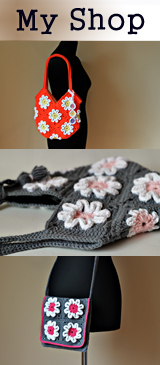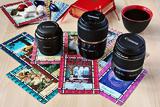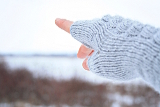
As I promised before in the post about my cameras, here I am with a couple of words about my lenses.
First of all, I love my lenses.
Very much.
Second of all, I just love them.
These are the names of the babies (from left to right): Canon 50mm F 1.8, Tamron Macro 60 mm F 2, Canon 18-55mm (which came as a kit lens with my Canon Rebel T2i camera).
I use the first one (Canon 50mm) to shoot food.
The Tamron 60 mm is great for food too, but since it is a macro lens I use it quite often outside to shoot flowers, bugs or other cute tiny things.
To capture wider angles, I use the Canon 18-55 (the kit lens).
Now let me show you and compare a few interesting features that these lenses possess.
1. Comparison with the Same Settings



Each of these shots was taken with a different lens. To make the comparison most accurate I kept the same settings for each shot. All pictures were taken at 5.6 aperture and they are not edited at all.
Though that last thing was a bit hard to digest.
I find these images pretty similar in their appearance. Maybe just the last one is a little colder in colors (has more blue tones in it) than the other two.
But there’s more to compare…
2. Lowering the Aperture (Blurry Background)
Well, who doesn’t like a nice blurry background.
That really injects the magic into the pictures, doesn’t it?
The part of the lens which provides for the blurriness of the picture is called the aperture (if you are not that familiar with this term you can find a little more about it here).
I love to use low aperture settings, especially for the food shots.
The kit lens that came with the camera (Canon 18-55mm) has the lowest aperture number of 5.6 (the second picture of this post shows you the result).
But I knew that there was a whole new world of possibilities when you go lower than 5.6.
So there came a moment in my life when I felt that I couldn’t go a day longer without a proper low aperture lens. That was when I got these two:

This picture was taken with the Canon 50mm at its lowest aperture – F 1.8.
See the blurry background? And how little portion of the picture is actually in focus? So that is caused by the low 1.8 aperture setting.
Again, this picture could really benefit from some vigorous Photoshop treatment, but this post is not about that.

This is a shot taken with the Tamron 60mm at 2.0 aperture (which is its lowest aperture number).
I like the blurriness of the background a lot.
In this aspect, these two lenses produce very similar results.
Also, these two lenses are prime, which means that you cannot zoom in or zoom out. In other words, they have fixed focal length. But that thing is perfectly all right – it makes you move a little more and stretch your body quite often which, I guess, is a nice health supporting benefit.
If the low aperture setting had been the only feature that I wanted for my pictures I would only have acquired the Canon 50mm lens. That one was much cheaper than the Tamron 60mm.
But I also needed Tamron. Have a look why…
3. Getting Closer to the Subject

This is closest that the Canon 50mm allows you to get to the subject.
If you go closer, the lens cannot focus anymore.

This is how close the Tamron 60mm allows you to get.
Amazing detail!
I often use this feature when taking pictures in my kitchen – spices, sugar or cake structure, that all looks perfectly detailed.
I love it!
So these are my beloved lenses.
I hope this information helped you.
At least a little.
… and psst, don’t tell this to my boyfriend

There’s also this cutie!
It’s the Canon 75-300mm telephoto zoom lens.
I frequently steal this one from my boyfriend to capture…

… squirrels …

… or baby orangutans, or basically anything that happens to be far away from me.
I think I love this lens much more than my boyfriend does and I also use it way more often.
So who really has the moral right to own it, I ask?
I think it’s me, I answer.
Definitely, it’s me!

It fills the last free space in my camera bag perfectly, anyway.



























































